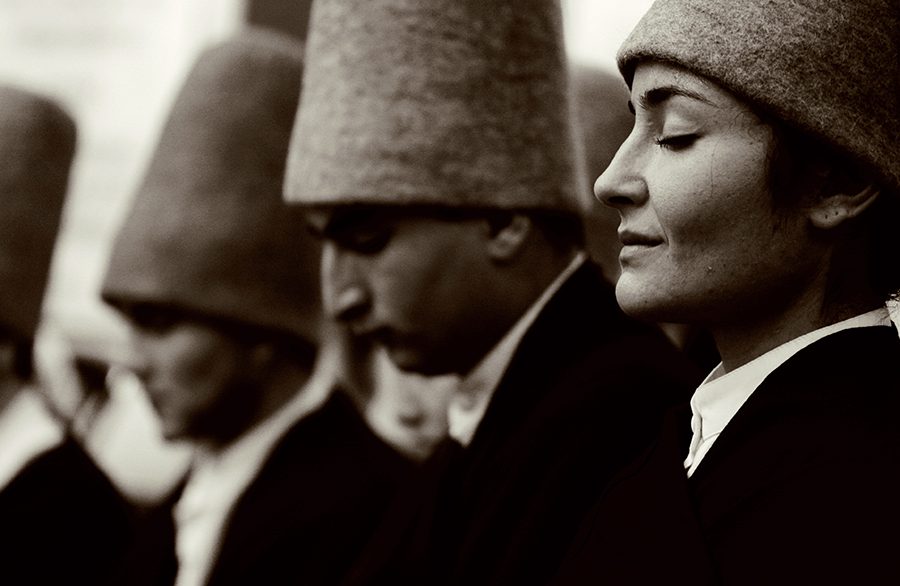What is a whirling dervish and why is it called that
What is a whirling dervish and why is it called that ?
The Mevlevi Order or Mawlawiyya (Turkish: Mevlevilik or Mevleviyye; Persian: طریقت مولویه) is a Sufi order that originated in Konya and which was founded by the followers of Jalaluddin Muhammad Balkhi Rumi, a 13th-century Persian poet, Sufi mystic, and Islamic theologian. The Mevlevis are also known as the “whirling dervishes” due to their famous practice of whirling as a form of dhikr (remembrance of God). Dervish is a common term for an initiate of the Sufi path; whirling is part of the formal sema ceremony and the participants are properly known as semazens.
In 2008, UNESCO confirmed “The Mevlevi Sema Ceremony” as amongst the Masterpieces of the Oral and Intangible Heritage of Humanity.
Approximately 750 years old, the Mevlevi Order is a living tradition based on the teachings of Rumi, also known as Mevlana, who is perhaps Turkey’s most celebrated poet and in Iran, second only to Hafiz. He is also venerated as a divine mystic within Sufi Islam. Rumi’s friend and spiritual mentor, Shams of Tabriz, is also revered within the order and within Sufism more widely.
Rumi said, “As long as I have life, I am the slave of the Quran. I am dust at the door of Muhammad the Chosen”, and the Mevlevi path is based firmly on Islamic principles. Kabir Helminski, a Mevlevi shaikh, writes ‘It is a rigorous path of initiation and service continually adapting itself to changing circumstances and times…. Mevlevis have always been progressive and liberal in spirit while at the same time conserving the best of tradition.’
The Mevlevis insist that love is at the centre of Islam. Mevlevi shaikh Şefik Can writes, ‘Rumi tells us to take the love of God to the forefront, to abstain from being attached to the letter of the law rather than the spirit of it, to find the essence of the faith, and to raise our faith from the level of imitation to the level of realization.’
In addition to obligatory Islamic worship, some of the main spiritual practices within the Mevlevi Order are as follows:
Dhikr: invocation of the Divine Names which is believed to purify the heart
Sema (sama): the whirling ceremony
Study of the Quran and Rumi’s works (especially his poetic masterpiece the Mathnavi)
Spiritual conversation led by the shaikh (sohbet)
Meditation (known as muraqabah in Islam)
Adab (developing courtesy and mindfulness)
-
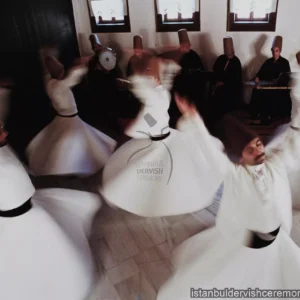 Whirling Dervish Ceremony in Sultanahmet980.00₺
Whirling Dervish Ceremony in Sultanahmet980.00₺ -
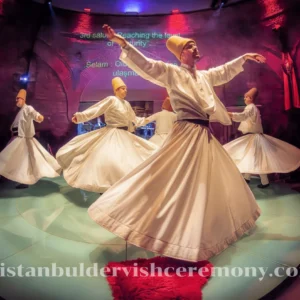 Hocapasha Culture Center Whirling Dervish Ceremony1,380.00₺
Hocapasha Culture Center Whirling Dervish Ceremony1,380.00₺ -
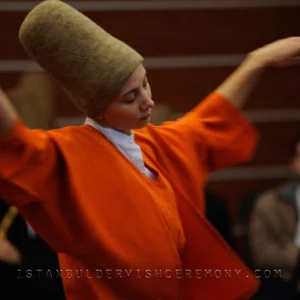 Whirling Dervish Ceremony Real Monastery in Fatih1,480.00₺
Whirling Dervish Ceremony Real Monastery in Fatih1,480.00₺ -
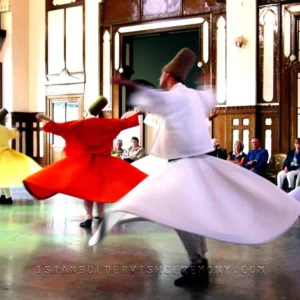 Whirling Dervish Ceremony in Sultanahmet Sirkeci Train Station200.00₺
Whirling Dervish Ceremony in Sultanahmet Sirkeci Train Station200.00₺ -
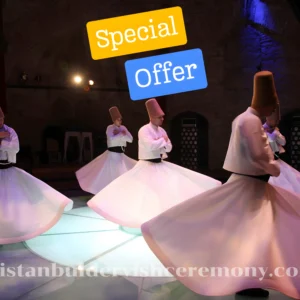 Hocapasha Culture Center Whirling Dervish Ceremony Happy Hour Ticket1,000.00₺
Hocapasha Culture Center Whirling Dervish Ceremony Happy Hour Ticket1,000.00₺ -
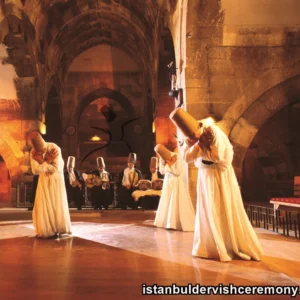 Whirling Dervish Ceremony in Saruhan Cappadocia1,300.00₺
Whirling Dervish Ceremony in Saruhan Cappadocia1,300.00₺ -
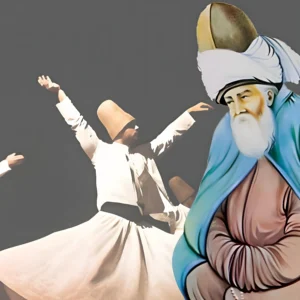 Seb-i Arus Rumi Ceremony in Istanbul1,480.00₺
Seb-i Arus Rumi Ceremony in Istanbul1,480.00₺ -
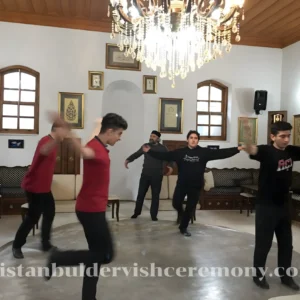 Learn How to do Sacred Whirling Dervish Dance4,600.00₺
Learn How to do Sacred Whirling Dervish Dance4,600.00₺ -
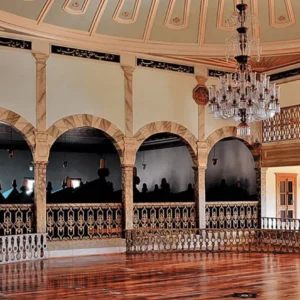 Yenikapı Mevlevihanesi Whirling Dervishes Show
Yenikapı Mevlevihanesi Whirling Dervishes Show
Sema
The Sema with the greatest significance to the Mevlevi order is the annual celebration of Mevlana’s marriage to god (death), also called Seb-i Arus, meaning Nuptial Night or Night of Union. It is observed for one week, with the final night occurring on the anniversary of his death. Pilgrims from all over the world travel to Konya for the official celebration. The event is so popular that a ticketing system is in place for those who wish to attend.
Rumi mentions whirling in a number of his poems. In one ghazal in the Divani Shamsi Tabriz he says:
Those who turn in the direction of prayer,
whirl in both this world and the next.
Pay heed when a circle of friends whirl,
circling round and round, the Kaaba is the center.
If you wish a mine of sugar, it is there;
and if you wish a fingertip of sugar, it is gratis.
According to a popular story, Rumi was first inspired to whirl when he heard the hammering of the goldsmiths in Konya’s bazaar, however, Mevlevi historian Abdülbâki Gölpınarlı believed that Rumi must have learnt whirling from Shams of Tabriz. Şefik Can claimed that whirling was practiced among Sufis at least as early as Abu Sa’id Abu’l-Khayr (d. 1049). Though they have cultivated it to the highest degree, Mevlevis are not the only Sufis who practice whirling, and Kabir Helminski suggests primordial origins: ‘The practice of whirling may have its origins in the timeless shadows of Central Asian spirituality where shamans used it to induce altered states of consciousness.’
Sema (or sama) is traditionally practised in a semahane (ritual hall) according to a precisely prescribed symbolic ritual with the semazens whirling in a circle around their shaikh. Semazens whirl using their right foot to propel themselves in a counter-clockwise circle, whilst their left foot remains rooted to the floor acting as an axis about which the semazen turns. Both arms are extended and raised to the level of the head, with the right palm pointing upward (believed to be receiving Divine grace) and the left palm pointing downward (believed to channel that grace to the world). With each 360° turn, the semazen is inwardly chanting “Allah” – a form of dhikr.
The semazens enter wearing a black cloak (hırka) symbolizing death and the grave, which they remove before whirling. On their heads they wear a tall, brown hat known as a sikke, which symbolizes the tombstone and the death of the ego (a version of the “Sikke” is also worn by the Bektashi). Once their cloaks are removed, their long white robes (tennûre) and white jackets (destegül – meaning ‘bouquet of roses’) become visible. Both are symbols of resurrection.
Structure of the ceremony
Naat-i Sharif – The naat marks the beginning of the ceremony in which a solo singer offers a eulogy to the Prophet Muhammad. It is concluded with a taksim (improvisation) on the reed flute (ney), which symbolises the Divine breath that gives life to everything.
Devr-i Veled – The Sultan Veled walk involves the semazens walking slowly and rhythmically to the peshrev music. After slapping the ground forcefully (representing the Divine act of creation when God said ‘Be!’ according to the Quran), they make a circuit in single file around the hall three times, bowing first to the semazen in front of them, and then to the semazen behind them as they begin each circuit. The bow is said to represent the acknowledgement of the Divine breath which has been breathed into all of us and is a salutation from soul to soul. The dervishes then remove their black cloaks.
The Four Salams – The Four Salams (Selams) form the main part of the ceremony and are distinct musical movements. According to Dr. Celalettin Celebi and Shaikh Kabir Helminski, ‘The first selam represents the human being’s birth to Truth through knowledge, and through his awareness and submission to God. The second selam represents the rapture of the human being while witnessing the splendour of creation and the omnipotence of God. The third selam is the transformation of rapture into love, the sacrifice of mind to love. It is annihilation of the self within the Loved One. It is complete submission. It is unity…. The fourth selam is the semazen’s coming to terms with his destiny. With the semazen’s whole self, with all his mind and heart, he is a servant of God, of God’s books and His prophets – of all Creation.’
Quranic recitation – The ceremony concludes with a recitation from the Quran, which normally includes the following verse: God is in the East and West. And wherever you turn, there is the face of God. (Quran 2:115)
History
The order was established after Rumi’s death in 1273 by his son Sultan Veled and Husameddin Chelebi (who inspired Rumi to write the Mathnavi). Like his father, Sultan Veled is celebrated for his poetry. Lyrics he wrote are often sung during the sema ceremony itself, and both he and Husameddin Chelebi are honoured within the order as accomplished Sufi mystics in their own right. It was they who had Rumi’s mausoleum built in Konya, which to this day is a place of pilgrimage for many Muslims (and non-Muslims). A number of Rumi’s successors, including both Sultan Veled and Husameddin Chelebi themselves, are also buried there. Their personal efforts to establish the order were continued by Sultan Veled’s son Ulu Arif Chelebi.
During the Ottoman period, the Mevlevi order spread into the Balkans, Syria, Lebanon, Egypt, and Palestine, especially in Jerusalem. The Bosnian writer Meša Selimović wrote the book The Dervish and Death about a Mevlevi dergah in Sarajevo. Eventually, there were as many as 114 Sufi lodges, the order becoming well established within the Ottoman Empire when Devlet Hatun, a descendant of Sultan Veled, married Bayezid I. Their son Mehmed I Çelebi became the next sultan, endowing the order, as did his successors, with many advantages. Many of the members of the order served in various official positions within the caliphate.
To this day, responsibility for overseeing the Mevlevi Order is passed down through the generations of Rumi’s male descendants. The head of the order is referred to as Çelebi (Chelebi) which means ‘man of God’ or ‘noble, courteous’ according to Mevlevi historian Abdülbâki Gölpınarlı. The current Çelebi is Faruk Hemdem Çelebi. He is also president of the International Mevlana Foundation (UluslararasI Mevlânâ Vakfi), a Turkish cultural and educational foundation managed by his sister and vice-president Esin Çelebi Bayru. Shaikhs, who have the authority to teach Mevlevi practices and philosophy, are appointed by the Çelebi.
Artistic heritage
Rumi’s Mathnavi and Diwan-e Shams-e Tabrizi are considered masterpieces of Persian literature, and throughout the centuries the Mevlevi Order has continued its long-standing association with the arts in Turkey. Apart from the works of Rumi and Sultan Veled, other famous literary works by Mevlevis include influential commentaries on Rumi’s Mathnavi by Ismāʿil Rusūhī Ankarawi (d. 1631) and Ismāʿil Ḥaqqı Burṣalı (d. 1724), the latter also being ‘a fine mystical poet’ in his own right. The most celebrated Mevlevi poet, after Rumi and Sultan Veled, is Shaykh Ghalib Dede (d. 1799), the author of Hüsn ü Aşk and ‘perhaps the last true master of Turkish classical poetry’ according to scholar Annemarie Schimmel. Both Ghālib Dede and Ankarawī are buried at the Galata Mevlevihanesi.
A significant number of the most celebrated Turkish musicians have been Mevlevis, and during the Ottoman era the Mevlevi Order produced a great deal of vocal and instrumental music. Mustafa Itri (1640–1712), an Ottoman-Turkish musician, composer, singer and poet, is regarded as the master of Turkish classical music. Ismail Dede (1778-1846) is also considered one of Turkey’s greatest classical composers and wrote the music for the ceremonial songs (ayins) played during the sema ceremony. Celebrated female musicians and composers include Dilhayat Khalifa (early 1700s) and Layla Saz (late 1800s – also buried at Galata Mevlevihanesi)
Women in the Mevlevi Order
Camille Helminski explains in her book, Women of Sufism, A Hidden Treasure, how Rumi had a number of noteworthy female students, and how in the early days of the order there were instances of female shaikhs and semazens, such as Destina Khatun (who was appointed shaykha of the Kara Hisar Mevlevi lodge). ‘In the early days of the Mevlevi order, women and men were known to pray, share sohbet (spiritual conversation), and whirl within each other’s company, though more often as the centuries unfolded, women held their own semas and men also whirled in zhikr separate from women. However, in the time of Mevlana [Rumi], spontaneous semas would occur including both men and women.’. In the same book, Camille Helminski presents a letter (dated from 1991) from Celaleddin Bakir Çelebi (who was the Çelebi heading the order at that time) which grants permission for men and women to once more whirl together in mixed Mevlevi ceremonies.
How can one participate?
You can make reservations from here ( online ), you can e-mail us or you can visit our ticket center in advanced and make your reservation in person. Here are our details ;
LOCATION of our Meeting Point in Sultanahmet :
https://goo.gl/maps/uXuyRmELZsx
Contact People : Mr. Alp – Mr. Nurdogan
( Phone : +90 544 220 10 22 / +90 212 527 68 59 )
Here is our address :
Google Maps : https://goo.gl/maps/uXuyRmELZsx
Istanbul Dervish Ceremony – Les Arts Turcs / Culture Center
Alemdar Mh. Incili Çavus St.
No: 19 Floor : 3 (Behind The Underground Cistern)
Sultanahmet 34400
Istanbul, Turkey
-
 Whirling Dervish Ceremony in Sultanahmet980.00₺
Whirling Dervish Ceremony in Sultanahmet980.00₺ -
 Hocapasha Culture Center Whirling Dervish Ceremony1,380.00₺
Hocapasha Culture Center Whirling Dervish Ceremony1,380.00₺ -
 Whirling Dervish Ceremony Real Monastery in Fatih1,480.00₺
Whirling Dervish Ceremony Real Monastery in Fatih1,480.00₺ -
 Whirling Dervish Ceremony in Sultanahmet Sirkeci Train Station200.00₺
Whirling Dervish Ceremony in Sultanahmet Sirkeci Train Station200.00₺ -
 Hocapasha Culture Center Whirling Dervish Ceremony Happy Hour Ticket1,000.00₺
Hocapasha Culture Center Whirling Dervish Ceremony Happy Hour Ticket1,000.00₺ -
 Whirling Dervish Ceremony in Saruhan Cappadocia1,300.00₺
Whirling Dervish Ceremony in Saruhan Cappadocia1,300.00₺ -
 Seb-i Arus Rumi Ceremony in Istanbul1,480.00₺
Seb-i Arus Rumi Ceremony in Istanbul1,480.00₺ -
 Learn How to do Sacred Whirling Dervish Dance4,600.00₺
Learn How to do Sacred Whirling Dervish Dance4,600.00₺ -
 Yenikapı Mevlevihanesi Whirling Dervishes Show
Yenikapı Mevlevihanesi Whirling Dervishes Show
